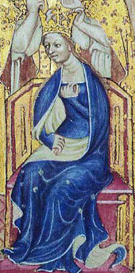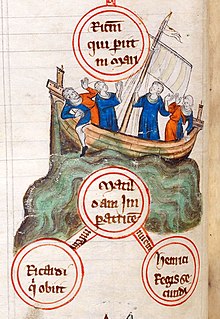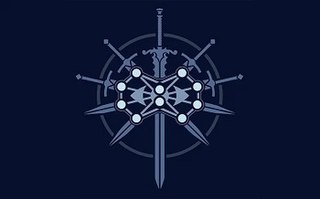
Anne of Bohemia, also known as Anne of Luxembourg, was Queen of England as the first wife of King Richard II. A member of the House of Luxembourg, she was the eldest daughter of Charles IV, Holy Roman Emperor and King of Bohemia, and Elizabeth of Pomerania. Her death at the age of 28 was believed to have been caused by plague.

Geoffrey V, called the Handsome, the Fair or Plantagenet, was the count of Anjou, Touraine and Maine by inheritance from 1129, and also Duke of Normandy by conquest from 1144. His marriage to Empress Matilda, daughter of King Henry I of England, led to the centuries-long reign of the Plantagenet dynasty in England. The name "Plantagenet" was taken from Geoffrey's epithet. Geoffrey's ancestral domain of Anjou gave rise to the name Angevin, and what modern historians name as the Angevin Empire in the 12th century.

Sharon Kay Penman was an American historical novelist, published in the UK as Sharon Penman. She was best known for the Welsh Princes trilogy and the Plantagenet series. In addition, she wrote four medieval mysteries, the first of which, The Queen's Man, was a finalist in 1996 for the Best First Mystery Edgar Award. Her novels and mysteries are set in England, France, and Wales, and are about English and Welsh royalty during the Middle Ages. The Sunne in Splendour, her first book, is a stand-alone novel about King Richard III of England and the Wars of the Roses. When the manuscript was stolen she started again and rewrote the book.

The White Ship was a vessel transporting many nobles, including the heir to the English throne, that sank in the Channel during a trip from France to England near the Normandy coast off Barfleur, on 25 November 1120. Only one of approximately 300 people aboard, a butcher from Rouen, survived. Those who drowned included William Adelin, the only legitimate son and heir of Henry I of England, his half-sister Matilda of Perche, his half-brother Richard of Lincoln, the earl of Chester Richard d'Avranches, and Geoffrey Ridel. William Adelin's death led to a succession crisis and a period of civil war in England from 1135 to 1153 known as the Anarchy.

Edward is an English given name. It is derived from the Anglo-Saxon form ÉᚪᛞǷᛠᚱᛞ or Éadƿeard, composed of the elements ead "wealth, fortune; prosperous" and ƿeard "guardian, protector".

Eleanor of England, was Queen of Castile and Toledo as wife of Alfonso VIII of Castile. She was the sixth child and second daughter of Henry II, King of England, and Eleanor of Aquitaine.

At the Battle of Edington, an army of the kingdom of Wessex under Alfred the Great defeated the Great Heathen Army led by the Dane Guthrum on a date between 6 and 12 May 878, resulting in the Treaty of Wedmore later the same year. Primary sources locate the battle at "Eðandun". Until a scholarly consensus linked the battle site with the present-day village of Edington in Wiltshire, it was known as the Battle of Ethandun. This name continues to be used.
Fulk I of Anjou — Foulques le Roux — held the county of Anjou first as viscount, then count, until his death.
The Saladin tithe, or the Aid of 1188, was a tax, or more specifically a tallage, levied in England and to some extent in France in 1188, in response to the capture of Jerusalem by Saladin in 1187.

The Harrying of the North refers to a series of campaigns waged by William the Conqueror in the winter of 1069–1070 to subjugate northern England, where the presence of the last Wessex claimant, Edgar Ætheling, had encouraged Anglo-Danish rebellions. William paid the Danes to go home, but the remaining rebels refused to meet him in battle, and he decided to starve them out by laying waste to the northern shires using scorched earth tactics, especially in the city of York, before relieving the English aristocracy of their positions, and installing Norman aristocrats throughout the region.
Alison Weir is a British author and public historian. She primarily writes about the history of English royal women and families, in the form of biographies that explore their historical setting. She has also written numerous works of historical fiction.
Plantagenet Somerset Fry, born Peter George Robin Fry, sometimes used the names 'Peter George Robin Somerset Fry' and 'Peter George Robin Plantagenet Somerset Fry', was a British historian and author of more than 50 books. In his youth, he added Somerset to his surname by deed poll, the Fry family originating from Wells in that county, and Plantagenet was a nickname which he adopted at university, relating to his advocacy of Richard III.

England in the Late Middle Ages concerns the history of England during the Late Middle Ages, from the thirteenth century, the end of the Angevins, and the accession of Henry III – considered by many to mark the start of the Plantagenet dynasty – until the accession to the throne of the Tudor dynasty in 1485, which is often taken as the most convenient marker for the end of the Middle Ages and the start of the English Renaissance and early modern Britain.

The Stormlight Archive is a series of epic fantasy novels written by American author Brandon Sanderson, planned to consist of ten novels. As of 2022, the series comprises four published novels and two novellas. The first novel, The Way of Kings, was published on August 31, 2010. The second novel, Words of Radiance, was published in 2014 and debuted at number one on The New York Times Best Seller List. A fifth novel is expected to be released in fall 2024, while writing for the latter half of the series will begin after Sanderson finishes writing the upcoming Era Three Mistborn trilogy.
1215: The Year of Magna Carta is a historical documentation of life in Medieval England written by author and journalist Danny Danziger and emeritus professor of history at the London School of Economics John Gillingham. It was originally published in 2003 by Hodder & Stoughton, a division of Hodder Headline. In 2004, it was published in the United States by Touchstone. This book is a sequel to Danziger's previous work, The Year 1000, which he co-authored with author Robert Lacey.

Daniel Gwynne Jones is a British historian, TV presenter, and journalist. He was educated at The Royal Latin School, a state grammar school in Buckingham, before attending Pembroke College, Cambridge.

John Hooper Harvey was an English architectural historian, who specialised in writing on English Gothic architecture and architects. Paul Crossley has described him as "the most prolific and arguably the most influential writer on Gothic architecture in the post-war years". He made extensive use of archival sources, and is particularly remembered for having – through his study of Henry Yevele (1944), and his biographical dictionary of English Mediaeval Architects (1954) – helped dispel the myth that the architects of medieval buildings were anonymous figures of whom little could be discovered. He also published more generally on England in the later middle ages, and was a pioneer in the field of garden history.

In heraldry, the royal badges of England comprise the heraldic badges that were used by the monarchs of the Kingdom of England.

The Angevins were a royal house of French origin that ruled England in the 12th and early 13th centuries; its monarchs were Henry II, Richard I and John. In the 10 years from 1144, two successive counts of Anjou in France, Geoffrey and his son, the future Henry II, won control of a vast assemblage of lands in western Europe that would last for 80 years and would retrospectively be referred to as the Angevin Empire. As a political entity this was structurally different from the preceding Norman and subsequent Plantagenet realms. Geoffrey became Duke of Normandy in 1144 and died in 1151. In 1152, his heir, Henry, added Aquitaine by virtue of his marriage to Eleanor of Aquitaine. Henry also inherited the claim of his mother, Empress Matilda, the daughter of King Henry I, to the English throne, to which he succeeded in 1154 following the death of King Stephen.
Britain's Bloodiest Dynasty is a British television documentary about the Plantagenets presented by Dan Jones and first broadcast from 27 November to 18 December 2014. The four-part documentary follows the period from Henry II to Richard II.














